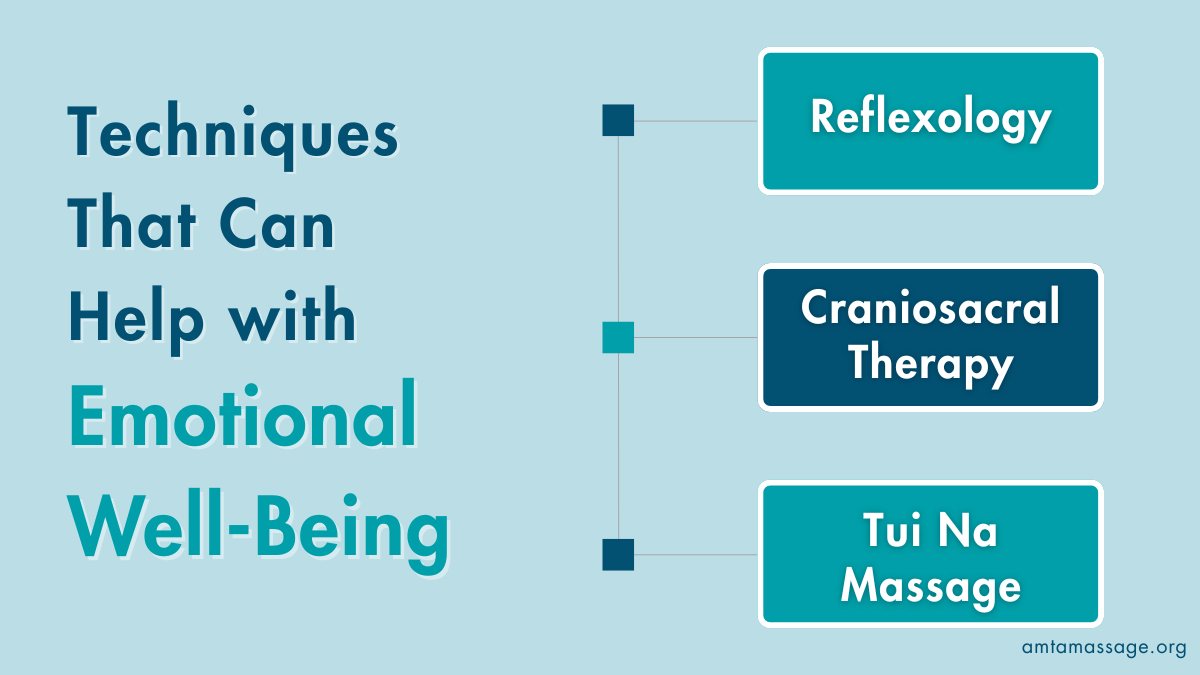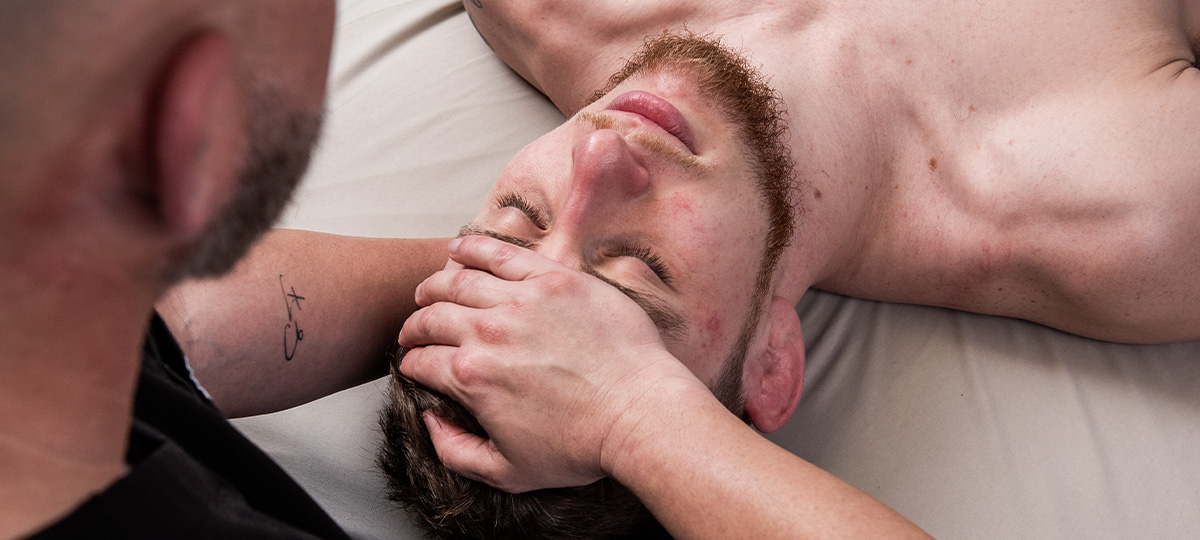Massage therapy is not just a modality to help with physical aches and pains. It also provides many benefits for mental well-being, such as decreasing stress, anxiety and depression. Many massage techniques that your clients might request for help managing physical symptoms of illness, injury or stress, for example, can also help their overall emotional and mental well-being.
“The biopsychosocial model posits that the experience of health is multidimensional, composed of interdependent factors,” says Erika Larson, LMT. “Physical well-being and emotional well-being are interwoven. While some clients may seek treatment primarily focused on one dimension of health, treatment effects cannot be restricted to a single dimension.”
Sometimes emotions are discussed in relation to massage therapy as being “trapped.” One goal of massage is to release these trapped emotions, which can have both physical and mental/emotional benefits.
“When an emotion is trapped, what is really being held is the actions or reactions the person wanted to take at the time the emotion was felt,” says Cindy Carlton, LMT/Intuitive Healing Facilitator. “If someone holds back those emotional actions over and over again, it can cause distress in the tissues—muscles and fascia that were used to hold back the reactions become tight or taut.” Massage therapy can be used to help relax and release the taut tissues, releasing the “emotional energy” being held.
“Almost any massage modality can cause an emotional release during a session, but there are certain types of massage that lend themselves well to emotional processing and healing,” says Ariel F. Hubbard, LMT. “Lymphatic massage is especially effective because it does tend to directly affect emotions through the lymphatic system.”
According to Hubbard, other factors that influence more fluid emotional processing include:
- Specific massage modalities that address the nervous, limbic or endocrine systems
- Modalities that facilitate a higher level of client safety, relaxation and calm
- Massaging regions of the body where emotions are stored and using massage modalities that process them directly.
Techniques such as reflexology, craniosacral therapy and Tui Na massage are also particularly effective in helping with emotional well-being. “Reflexology affects the nervous system and the endocrine system, and via these systems, all regions of the body wherever emotions may be stored,” Hubbard says. “Craniosacral therapy is also very effective because it treats the central nervous system and limbic system directly. Tui Na massage is effective because it can be used to address acupoints that treat certain emotions, but also because the movement in this modality can calm and reset the nervous system.”

Carlton also mentions using craniosacral therapy, as well as somatic emotional release (SER), even during sessions that may be primarily using deep tissue, Swedish and myofascial release techniques.
“Using the gentle touch techniques from craniosacral therapy/SER and energy work helps one to tune into the more subtle holding patterns in a person’s body. It’s in the ‘holding space’ for the tensions to release that the emotional energy can also be released,” Carlton says.
The Client/Therapist Relationship’s Effect on Emotions
One factor of a massage therapy session that goes beyond technique that can drastically improve its effect on mental well-being is the therapist’s ability to honor the client’s conceptual boundaries.
“Conceptual boundaries are the way the client sees their world. Their belief systems about the nature of reality; their political beliefs; their experiences with race or gender; their age, and many more factors will affect their conceptual boundaries,” Hubbard says. “When a massage therapist listens to a client from the client’s perspective, and does their best to reduce or eliminate their own implicit bias, clients feel safe, listened to, nurtured, validated and relaxed. Then, they tend to process emotions more easily.”
It is always important to respect a client’s boundaries, both physical and emotional, as doing so creates an environment of trust, which, in turn, can help a client relax and in some cases experience an emotional release.
Massage therapists are not psychotherapists, however, and that is critical to remember when working with all clients. If any client experiences some sort of emotional release during a massage session, the massage therapist should simply allow it to happen and not attempt to intervene or offer any advice.
“What really makes the massage session a safe place for emotional well-being and healing is the practitioner and how comfortable they are with the client releasing emotional energy,” says Carlton. “If the practitioner is uncomfortable with a client crying or needing to express how their feeling about something, then the client’s physical body isn’t going to feel comfortable or safe to release the emotional energy being held in the tissues.”
The communication between a client and the massage therapist can help the client improve their interoceptive awareness, which includes a sense of one’s emotional state.
“In addition, the style of communication between the therapeutic massage and bodywork practitioner and client encourages the view of symptoms as messages, fostering the act and art of noticing,” Larson says.
Massage Therapy’s Effect on Stress: What the Research Shows
One study1 examined infant massage as a stress management technique—not for the infants, but for the parents of hospitalized extremely preterm infants. The stress of having a newborn in the NICU for an extended period can be very stressful for the parents of these preterm infants.
Parent-administered infant massage is a well-established intervention for preterm infants that has been shown to have benefits for both the infants and the parents. Still, the majority of the published literature has mostly examined the impact via self-reported or observational measures of stress. This study sought to measure the reduction of stress via salivary cortisol, a biomarker for stress.
The salivary cortisol of both the infants and the mothers in 22 participant pairs was measured via buccal swab immediately pre- and post-parent-administered massage to detect any potential changes in physiological stress.
The study found a clinically significant decrease in maternal cortisol levels immediately post-parent-administered massage, indicating decreased physiological stress and suggesting that the act of administering the massage can help improve the mental and emotional well-being of the mother.
Another study2 assessed the effect of music therapy and hand massage on pain, fear and stress among 12–18 year old adolescents in the pediatric intensive care unit.
The participants were divided into three groups comprising 33 receiving hand massage, 33 receiving music therapy and 33 in a control group. Results were measured using the Wong- Baker FACES Pain Rating Scale, Children’s Fear Scale (CFS) and blood cortisol levels.
The study found that both the music therapy group and the hand massage group had lower CFS mean points by a significant level before and during the blood draw procedure compared to the control group.
Researchers concluded hand massage and music therapy were more effective than standard care at reducing both pain and fear levels during blood drawing among 12–18 year-old adolescents. Mean cortisol levels, however, did not show a significant difference among any of the groups.

